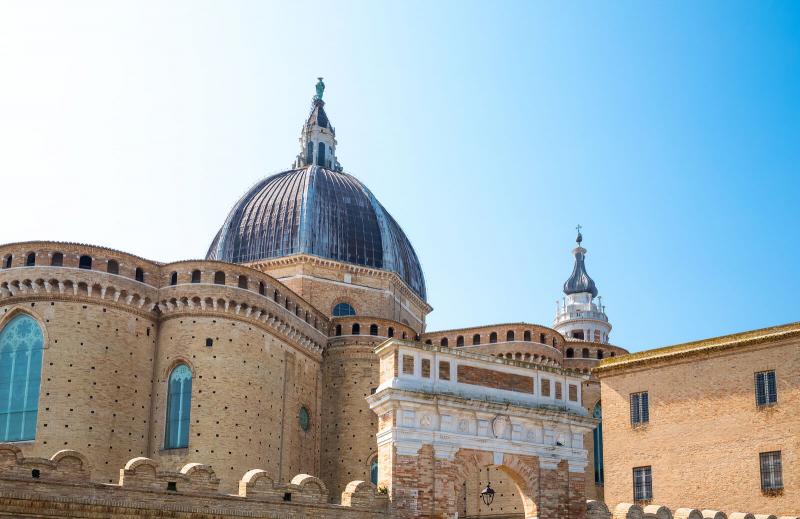Spiritual Le Marche: Loreto, the Unlikely Site of a Marian Devotion
ITA:

Pilgrims have been visiting the sanctuary of Loreto for a long time, since the ‘Holy House of Nazareth,’ the house where the Virgin Mary is thought to have lived, arrived in this hill town in Le Marche in 1294. Studies seem to confirm that the house is originally from Palestine, both for the architectural style and the building materials, unheard of in the territory of Le Marche.
The Holy House is inside the Basilica della Santa Casa, whose construction began in 1469. Its Istrian stone façade is flanked by a 75-meter-high bell tower from the mid-18th century. The simple stone walls of the Holy House are covered with a marble screen richly decorated with statues and reliefs, made by some of the most renowned artists of the time, based on a design by Bramante; the caliber of the artists called to work on this masterpiece of 16th-century sculpture reveals the spiritual importance placed on the site. It is in this house, it is believed, that Mary received the Annunciation.
Through the centuries, many artists have worked to embellish the Basilica. Among the many chapels, paintings and statues, a must-see is the Sala del Pomarancio, or Room of the Treasury, which contains a large number of votive offerings.
To better immerse yourself in the spiritual atmosphere of Loreto, climb the 330 steps of the Holy Staircase, just like pilgrims do, and reach the Basilica via the Porta Marina, one of the access gates to the sanctuary.
The grandeur of the Basilica is enhanced by the massive fortifications built to defend the sanctuary from Turkish attacks coming from the Adriatic. Walk along the sentry walkways used in the past to watch out for the enemy and enjoy the panoramic views.
Today, the Basilica is one of the most important Marian pilgrimage shrines in the world, but it is also visited by non-Catholics as well for the quality of the art and the spiritual appeal of the site.
Il santuario di Loreto è meta di pellegrinaggio da lungo tempo, sin da quando, nel 1294, la Santa Casa di Nazaret, la casa in cui si pensa sia vissuta la Vergine Maria, arrivò in questa città tra le colline marchigiane. Gli studi sembrano confermare che la casa sia originaria della Palestina, sia per lo stile architettonico che per i materiali da costruzione, sconosciuti nel territorio delle Marche.
La casa si trova all'interno della Basilica della Santa Casa, la cui costruzione iniziò nel 1469. La sua facciata in pietra d’Istria è affiancata da un campanile di 75 metri della metà del XVIII° secolo. Le semplici pareti in pietra della Casa Santa sono coperte da un rivestimento in marmo riccamente decorato con statue e rilievi, realizzati da alcuni dei più rinomati artisti dell'epoca, su disegno del Bramante; il calibro degli artisti chiamati a lavorare a questo capolavoro della scultura del XVI° secolo rivela l'importanza spirituale data al sito. È in questa casa, si crede, che Maria ricevette l'Annunciazione.
Attraverso i secoli, molti artisti hanno lavorato per impreziosire la Basilica. Tra le molte cappelle, i dipinti e le statue, da visitare è la Sala del Pomarancio, o Sala del Tesoro, che contiene un gran numero di offerte votive.
Per immergersi meglio nell'atmosfera spirituale di Loreto, è consigliato salire i 330 gradini della Scala Santa, proprio come fanno i pellegrini, e raggiungere la Basilica attraverso la Porta Marina, una delle porte di accesso al santuario.
La maestosità della Basilica è data anche dalle massicce fortificazioni costruite per difendere il santuario dagli attacchi dei turchi provenienti dall'Adriatico. Consigliata è la passeggiata lungo i camminamenti di ronda, utilizzati in passato per scorgere l’arrivo del nemico, per godere delle vedute panoramiche.
Oggi la Basilica è uno dei più importanti santuari mariani al mondo, ma è visitata anche da non credenti per la bellezza dell'arte che custodisce e la suggestione spirituale del luogo.











